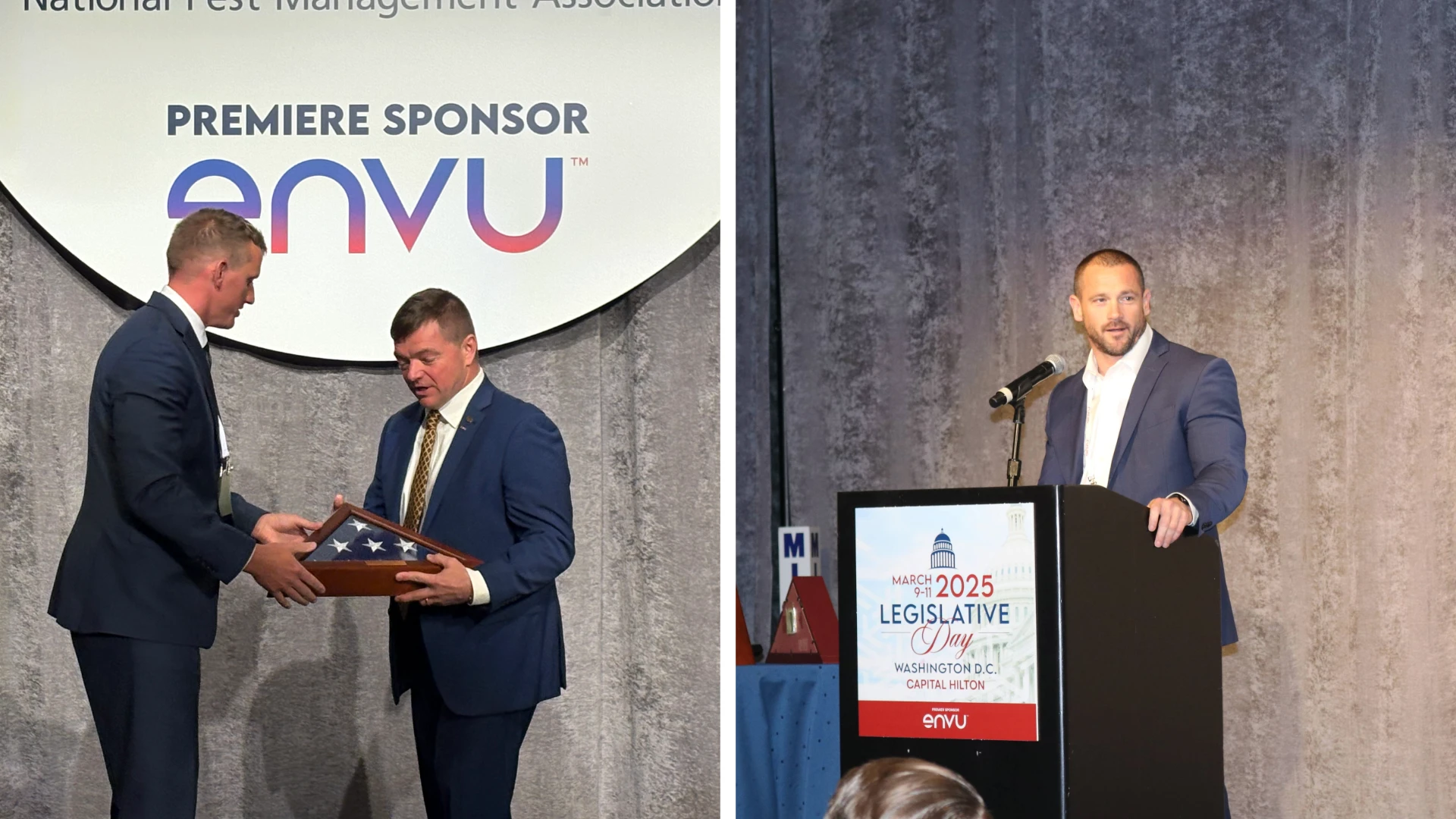Vince Parman, a student of Dr. Ed Vargo at North Carolina State University and field development specialist for Bayer Environmental Science, was in the final stages of completing his Ph.D. degree in entomology when he passed away unexpectedly in January 2007.
“It was in pursuit of the science behind pest management where I got to know Vince as his Ph.D. advisor,” Vargo said as he began his presentation at the National Pest Management Association’s PestWorld 2007. “Although Vince was not able to see his work though, the best way to honor him and his career is to honor his work. That’s what I’m here to do today.”
In an educational session sponsored by Pi Chi Omega, Vargo presented Parman’s field research, which brought to life what Vargo described as groundbreaking results. While Parman’s main thesis objective was to determine if imidacloprid, a non-repellent liquid termiticide, would eliminate subterranean termite colonies under field conditions, his methodology revealed new intelligence about subterranean termite colony size, composition, density and foraging areas in North Carolina and the surrounding areas.
According to Vargo, Parman’s results support a strong colony-level effect of imidacloprid in the field and provide the most detailed and broad-scale view of subterranean termite colonies located in and around residential properties to date.
METHODOLOGY. To monitor the fate of colonies around 20 residential properties, Parman installed an extensive grid system of below-ground stations around infested structures and collected samples for about one year.
“On average, he installed 70 monitors per structure. He collected samples from mud tubes in the structure, from the monitors and from wood debris in natural outlying areas for up to 14 months to genotype samples and identify various colonies before treatment was done,” Vargo explained. “It was a challenge to convince homeowners that although they had a termite problem, they would need to wait a year before it would be treated so we could determine where the colonies were. Vince successfully talked them into it, and was able to do the study.”
COLONY IDENTIFICATION. Parman identified 187 colonies around 20 residential properties. Ninety-one percent were Reticuliterrmes flavipes, 7 percent were R. hageni and 2 percent were R. virginicus. Parman used molecular genetic methods to distinguish foragers belonging to different colonies and to “fingerprint” colonies for redetection. In the process, he collected more than 10,000 genotypes and had only 200 more to process.
“As a result, we were able to construct detailed maps of all the termite colonies around the 20 structures, which is a huge data set,” Vargo said. “If you look through industry literature, you might get a map of one or two properties, done using less sophisticated methods where it is much harder to tell colonies apart. Using genetic markers, the colonies are typed as family groups based on their DNA, so we always have a record of which colony they belong to.”
LOCATION AND DENSITY. Most of the houses were infested by a single colony of R. flavipes, although four had been attacked by two colonies. The majority of the colonies were located in the natural areas bordering the lawn and yard. Colony densities averaged 25 colonies per acre, and varied from nine to 95 colonies per acre.
“Not much has been written about colony density in terms of how many colonies you are likely to find in or around a given size structure,” Vargo said. “It’s very hard to find this information, but now we have a wealth of it, thanks to Vince.”
FORAGING AREAS. Parman had predicted that colonies forage over fairly large distances, but found that was not necessarily the case in North and South Carolina, depending on the species.
“Nearly all the R. flavipes and R. hageni colonies had localized foraging areas, usually less than 30 linear feet for R. flavipes and less than 15 linear feet for R. hageni,” Vargo explained. “Reticulitermes virginicus had the most expansive colonies. On average, they spanned more than 53 and up to 160 linear feet, and averaged 100 square feet of foraging area, with maximum of almost 3,500.”
COLONY COMPOSITION. Most colonies were headed by a single pair of reproductives, most likely the original primary reproductives that founded the colony. When secondary reproductives were present in colonies, there were probably very few of them and they were not highly inbred.
“It’s been generally assumed that termite colonies live through several generations of reproductives and that most colonies would be headed by secondary reproductives, but that does not appear to be the case in North and South Carolina and some areas of Virginia,” Vargo said. “Our studies show that most colonies have their primary reproductives, which tells us that most of them don’t live long enough to produce secondary reproductives.”
TERMITICIDE EFFECTS. After 12 of the 20 structures were treated with imidaclorprid at the labeled rate, Parman continued to sample for two years. Termite activity within treated houses ceased within 90 days.
“Of the 12 properties receiving treatment with imidaclorprid, 14 colonies were treated and 13 of them were no longer detectable within 90 days after treatment, and often much earlier,” Vargo said. “Only a single treated colony continued to persist in a stump in the yard after treatment.”
According to Vargo, Parman’s research provides critical new information on subterranean termite biology and behavior as well as the effects of imidaclorprid in the field. Results indicate that the subterranean termite density is fairly high in the North Carolina and surrounding areas, although foraging areas are generally small. Most colonies are headed by the original king and queen, with secondary reproductives of the original colonies heading the rest. Finally, imidacloprid treatment has strong colony-level effects in the field, suggesting it results in suppression or elimination of subterranean termite colonies infesting houses.
Vargo and his associates are in the process of completing the study for Parman, who had only 200 genotypes to process at the time of his death.
To conclude the session, Dr. Vargo introduced and played a video produced by Bayer Environmental Science that captured Parman’s “commitment to strong science, his devotion to the industry and his overall good nature.
“These are just some of the things we will remember him for,” Vargo said. “Vince was not only my student, but also a respected colleague and good friend. He and his important contributions to urban entomology will be sorely missed.”
The author is a freelance writer based in Muskego, Wis.
About Vince Parman
Vince Parman had a long and distinguished career in entomology, graduating with a bachelor’s degree in entomology in 1979 and a master’s degree in entomology in 1981, both from Purdue University. He joined Union Carbide in 1981 as a research biologist, and he continued to work in the industry throughout his career. For the last six years, he served as a field development specialist at Bayer Environmental Science.
Bayer has endowed the Vince Parman Memorial Lecture Series in the Department of Entomology at North Carolina State to honor Parman and his contributions to urban entomology, and to help inspire the next generation of urban entomologists.

Explore the February 2008 Issue
Check out more from this issue and find your next story to read.
Latest from Pest Control Technology
- Understanding Rodents and Bird Flu
- Green Pest Solutions Awards Safest Driver New 2025 Ford F150
- UF/IFAS Sheds Light on Tiny Invaders During Termite Awareness Week
- Registration Open for Lawn & Landscape Technology Conference
- Fleetio Launches Automotive Service Excellence Scholarship
- WorkWave Appoints John Phelan as CTO
- PMPs Use Capitol Hill Visits to Push for Preemption
- 20 Trapping Tips





